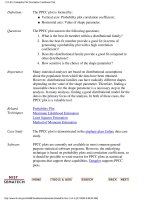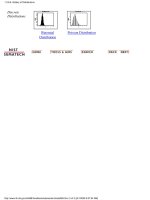Engineering Statistics Handbook Episode 2 Part 8 doc
Bạn đang xem bản rút gọn của tài liệu. Xem và tải ngay bản đầy đủ của tài liệu tại đây (62.43 KB, 20 trang )
115.876 128.565
84 100.980 106.395 111.242
117.057 129.804
85 102.079 107.522 112.393
118.236 131.041
86 103.177 108.648 113.544
119.414 132.277
87 104.275 109.773 114.693
120.591 133.512
88 105.372 110.898 115.841
121.767 134.746
89 106.469 112.022 116.989
122.942 135.978
90 107.565 113.145 118.136
124.116 137.208
91 108.661 114.268 119.282
125.289 138.438
92 109.756 115.390 120.427
126.462 139.666
93 110.850 116.511 121.571
127.633 140.893
94 111.944 117.632 122.715
128.803 142.119
95 113.038 118.752 123.858
129.973 143.344
96 114.131 119.871 125.000
131.141 144.567
97 115.223 120.990 126.141
132.309 145.789
98 116.315 122.108 127.282
133.476 147.010
99 117.407 123.225 128.422
134.642 148.230
100 118.498 124.342 129.561
135.807 149.449
100 118.498 124.342 129.561
1.3.6.7.4. Critical Values of the Chi-Square Distribution
(8 of 15) [5/1/2006 9:58:28 AM]
135.807 149.449
Lower critical values of chi-square distribution with degrees of
freedom
Probability of exceeding the
critical value
0.90 0.95 0.975
0.99 0.999
1. .016 .004 .001
.000 .000
2. .211 .103 .051
.020 .002
3. .584 .352 .216
.115 .024
4. 1.064 .711 .484
.297 .091
5. 1.610 1.145 .831
.554 .210
6. 2.204 1.635 1.237
.872 .381
7. 2.833 2.167 1.690
1.239 .598
8. 3.490 2.733 2.180
1.646 .857
9. 4.168 3.325 2.700
2.088 1.152
10. 4.865 3.940 3.247
1.3.6.7.4. Critical Values of the Chi-Square Distribution
(9 of 15) [5/1/2006 9:58:28 AM]
2.558 1.479
11. 5.578 4.575 3.816
3.053 1.834
12. 6.304 5.226 4.404
3.571 2.214
13. 7.042 5.892 5.009
4.107 2.617
14. 7.790 6.571 5.629
4.660 3.041
15. 8.547 7.261 6.262
5.229 3.483
16. 9.312 7.962 6.908
5.812 3.942
17. 10.085 8.672 7.564
6.408 4.416
18. 10.865 9.390 8.231
7.015 4.905
19. 11.651 10.117 8.907
7.633 5.407
20. 12.443 10.851 9.591
8.260 5.921
21. 13.240 11.591 10.283
8.897 6.447
22. 14.041 12.338 10.982
9.542 6.983
23. 14.848 13.091 11.689
10.196 7.529
24. 15.659 13.848 12.401
10.856 8.085
25. 16.473 14.611 13.120
11.524 8.649
26. 17.292 15.379 13.844
12.198 9.222
27. 18.114 16.151 14.573
12.879 9.803
28. 18.939 16.928 15.308
1.3.6.7.4. Critical Values of the Chi-Square Distribution
(10 of 15) [5/1/2006 9:58:28 AM]
13.565 10.391
29. 19.768 17.708 16.047
14.256 10.986
30. 20.599 18.493 16.791
14.953 11.588
31. 21.434 19.281 17.539
15.655 12.196
32. 22.271 20.072 18.291
16.362 12.811
33. 23.110 20.867 19.047
17.074 13.431
34. 23.952 21.664 19.806
17.789 14.057
35. 24.797 22.465 20.569
18.509 14.688
36. 25.643 23.269 21.336
19.233 15.324
37. 26.492 24.075 22.106
19.960 15.965
38. 27.343 24.884 22.878
20.691 16.611
39. 28.196 25.695 23.654
21.426 17.262
40. 29.051 26.509 24.433
22.164 17.916
41. 29.907 27.326 25.215
22.906 18.575
42. 30.765 28.144 25.999
23.650 19.239
43. 31.625 28.965 26.785
24.398 19.906
44. 32.487 29.787 27.575
25.148 20.576
45. 33.350 30.612 28.366
25.901 21.251
46. 34.215 31.439 29.160
1.3.6.7.4. Critical Values of the Chi-Square Distribution
(11 of 15) [5/1/2006 9:58:28 AM]
26.657 21.929
47. 35.081 32.268 29.956
27.416 22.610
48. 35.949 33.098 30.755
28.177 23.295
49. 36.818 33.930 31.555
28.941 23.983
50. 37.689 34.764 32.357
29.707 24.674
51. 38.560 35.600 33.162
30.475 25.368
52. 39.433 36.437 33.968
31.246 26.065
53. 40.308 37.276 34.776
32.018 26.765
54. 41.183 38.116 35.586
32.793 27.468
55. 42.060 38.958 36.398
33.570 28.173
56. 42.937 39.801 37.212
34.350 28.881
57. 43.816 40.646 38.027
35.131 29.592
58. 44.696 41.492 38.844
35.913 30.305
59. 45.577 42.339 39.662
36.698 31.020
60. 46.459 43.188 40.482
37.485 31.738
61. 47.342 44.038 41.303
38.273 32.459
62. 48.226 44.889 42.126
39.063 33.181
63. 49.111 45.741 42.950
39.855 33.906
64. 49.996 46.595 43.776
1.3.6.7.4. Critical Values of the Chi-Square Distribution
(12 of 15) [5/1/2006 9:58:28 AM]
40.649 34.633
65. 50.883 47.450 44.603
41.444 35.362
66. 51.770 48.305 45.431
42.240 36.093
67. 52.659 49.162 46.261
43.038 36.826
68. 53.548 50.020 47.092
43.838 37.561
69. 54.438 50.879 47.924
44.639 38.298
70. 55.329 51.739 48.758
45.442 39.036
71. 56.221 52.600 49.592
46.246 39.777
72. 57.113 53.462 50.428
47.051 40.519
73. 58.006 54.325 51.265
47.858 41.264
74. 58.900 55.189 52.103
48.666 42.010
75. 59.795 56.054 52.942
49.475 42.757
76. 60.690 56.920 53.782
50.286 43.507
77. 61.586 57.786 54.623
51.097 44.258
78. 62.483 58.654 55.466
51.910 45.010
79. 63.380 59.522 56.309
52.725 45.764
80. 64.278 60.391 57.153
53.540 46.520
81. 65.176 61.261 57.998
54.357 47.277
82. 66.076 62.132 58.845
1.3.6.7.4. Critical Values of the Chi-Square Distribution
(13 of 15) [5/1/2006 9:58:28 AM]
55.174 48.036
83. 66.976 63.004 59.692
55.993 48.796
84. 67.876 63.876 60.540
56.813 49.557
85. 68.777 64.749 61.389
57.634 50.320
86. 69.679 65.623 62.239
58.456 51.085
87. 70.581 66.498 63.089
59.279 51.850
88. 71.484 67.373 63.941
60.103 52.617
89. 72.387 68.249 64.793
60.928 53.386
90. 73.291 69.126 65.647
61.754 54.155
91. 74.196 70.003 66.501
62.581 54.926
92. 75.100 70.882 67.356
63.409 55.698
93. 76.006 71.760 68.211
64.238 56.472
94. 76.912 72.640 69.068
65.068 57.246
95. 77.818 73.520 69.925
65.898 58.022
96. 78.725 74.401 70.783
66.730 58.799
97. 79.633 75.282 71.642
67.562 59.577
98. 80.541 76.164 72.501
68.396 60.356
99. 81.449 77.046 73.361
69.230 61.137
100. 82.358 77.929 74.222
1.3.6.7.4. Critical Values of the Chi-Square Distribution
(14 of 15) [5/1/2006 9:58:28 AM]
70.065 61.918
1.3.6.7.4. Critical Values of the Chi-Square Distribution
(15 of 15) [5/1/2006 9:58:28 AM]
16 2.665 76 2.441
17 2.647 77 2.441
18 2.631 78 2.440
19 2.617 79 2.439
20 2.605 80 2.439
21 2.594 81 2.438
22 2.584 82 2.437
23 2.574 83 2.437
24 2.566 84 2.436
25 2.558 85 2.436
26 2.551 86 2.435
27 2.545 87 2.435
28 2.539 88 2.434
29 2.534 89 2.434
30 2.528 90 2.433
31 2.524 91 2.432
32 2.519 92 2.432
33 2.515 93 2.431
34 2.511 94 2.431
35 2.507 95 2.431
36 2.504 96 2.430
37 2.501 97 2.430
38 2.498 98 2.429
39 2.495 99 2.429
40 2.492 100 2.428
41 2.489 101 2.428
42 2.487 102 2.428
43 2.484 103 2.427
44 2.482 104 2.427
45 2.480 105 2.426
46 2.478 106 2.426
47 2.476 107 2.426
48 2.474 108 2.425
49 2.472 109 2.425
50 2.470 110 2.425
51 2.469 111 2.424
52 2.467 112 2.424
53 2.466 113 2.424
54 2.464 114 2.423
55 2.463 115 2.423
56 2.461 116 2.423
57 2.460 117 2.422
58 2.459 118 2.422
59 2.457 119 2.422
60 2.456 120 2.422
1.3.6.7.5. Critical Values of the t* Distribution
(2 of 3) [5/1/2006 9:58:28 AM]
1.3.6.7.5. Critical Values of the t* Distribution
(3 of 3) [5/1/2006 9:58:28 AM]
Critical values of the normal PPCC for testing if data come from
a normal distribution
N 0.01 0.05
3 0.8687 0.8790
4 0.8234 0.8666
5 0.8240 0.8786
6 0.8351 0.8880
7 0.8474 0.8970
8 0.8590 0.9043
9 0.8689 0.9115
10 0.8765 0.9173
11 0.8838 0.9223
12 0.8918 0.9267
13 0.8974 0.9310
14 0.9029 0.9343
15 0.9080 0.9376
16 0.9121 0.9405
17 0.9160 0.9433
18 0.9196 0.9452
19 0.9230 0.9479
20 0.9256 0.9498
21 0.9285 0.9515
22 0.9308 0.9535
23 0.9334 0.9548
24 0.9356 0.9564
25 0.9370 0.9575
26 0.9393 0.9590
27 0.9413 0.9600
28 0.9428 0.9615
29 0.9441 0.9622
30 0.9462 0.9634
31 0.9476 0.9644
32 0.9490 0.9652
33 0.9505 0.9661
34 0.9521 0.9671
35 0.9530 0.9678
36 0.9540 0.9686
37 0.9551 0.9693
38 0.9555 0.9700
39 0.9568 0.9704
1.3.6.7.6. Critical Values of the Normal PPCC Distribution
(2 of 4) [5/1/2006 9:58:29 AM]
40 0.9576 0.9712
41 0.9589 0.9719
42 0.9593 0.9723
43 0.9609 0.9730
44 0.9611 0.9734
45 0.9620 0.9739
46 0.9629 0.9744
47 0.9637 0.9748
48 0.9640 0.9753
49 0.9643 0.9758
50 0.9654 0.9761
55 0.9683 0.9781
60 0.9706 0.9797
65 0.9723 0.9809
70 0.9742 0.9822
75 0.9758 0.9831
80 0.9771 0.9841
85 0.9784 0.9850
90 0.9797 0.9857
95 0.9804 0.9864
100 0.9814 0.9869
110 0.9830 0.9881
120 0.9841 0.9889
130 0.9854 0.9897
140 0.9865 0.9904
150 0.9871 0.9909
160 0.9879 0.9915
170 0.9887 0.9919
180 0.9891 0.9923
190 0.9897 0.9927
200 0.9903 0.9930
210 0.9907 0.9933
220 0.9910 0.9936
230 0.9914 0.9939
240 0.9917 0.9941
250 0.9921 0.9943
260 0.9924 0.9945
270 0.9926 0.9947
280 0.9929 0.9949
290 0.9931 0.9951
300 0.9933 0.9952
310 0.9936 0.9954
320 0.9937 0.9955
330 0.9939 0.9956
340 0.9941 0.9957
350 0.9942 0.9958
1.3.6.7.6. Critical Values of the Normal PPCC Distribution
(3 of 4) [5/1/2006 9:58:29 AM]
360 0.9944 0.9959
370 0.9945 0.9960
380 0.9947 0.9961
390 0.9948 0.9962
400 0.9949 0.9963
410 0.9950 0.9964
420 0.9951 0.9965
430 0.9953 0.9966
440 0.9954 0.9966
450 0.9954 0.9967
460 0.9955 0.9968
470 0.9956 0.9968
480 0.9957 0.9969
490 0.9958 0.9969
500 0.9959 0.9970
525 0.9961 0.9972
550 0.9963 0.9973
575 0.9964 0.9974
600 0.9965 0.9975
625 0.9967 0.9976
650 0.9968 0.9977
675 0.9969 0.9977
700 0.9970 0.9978
725 0.9971 0.9979
750 0.9972 0.9980
775 0.9973 0.9980
800 0.9974 0.9981
825 0.9975 0.9981
850 0.9975 0.9982
875 0.9976 0.9982
900 0.9977 0.9983
925 0.9977 0.9983
950 0.9978 0.9984
975 0.9978 0.9984
1000 0.9979 0.9984
1.3.6.7.6. Critical Values of the Normal PPCC Distribution
(4 of 4) [5/1/2006 9:58:29 AM]
1. Exploratory Data Analysis
1.4. EDA Case Studies
1.4.1.Case Studies Introduction
Purpose The purpose of the first eight case studies is to show how EDA
graphics and quantitative measures and tests are applied to data from
scientific processes and to critique those data with regard to the
following assumptions that typically underlie a measurement process;
namely, that the data behave like:
random drawings
●
from a fixed distribution●
with a fixed location●
with a fixed standard deviation●
Case studies 9 and 10 show the use of EDA techniques in
distributional modeling and the analysis of a designed experiment,
respectively.
Y
i
= C + E
i
If the above assumptions are satisfied, the process is said to be
statistically "in control" with the core characteristic of having
"predictability". That is, probability statements can be made about the
process, not only in the past, but also in the future.
An appropriate model for an "in control" process is
Y
i
= C + E
i
where C is a constant (the "deterministic" or "structural" component),
and where E
i
is the error term (or "random" component).
The constant C is the average value of the process it is the primary
summary number which shows up on any report. Although C is
(assumed) fixed, it is unknown, and so a primary analysis objective of
the engineer is to arrive at an estimate of C.
This goal partitions into 4 sub-goals:
Is the most common estimator of C,
, the best estimator for
C? What does "best" mean?
1.
If
is best, what is the uncertainty for . In particular, is2.
1.4.1. Case Studies Introduction
(1 of 4) [5/1/2006 9:58:29 AM]
the usual formula for the uncertainty of :
valid? Here, s is the standard deviation of the data and N is the
sample size.
If is not the best estimator for C, what is a better estimator
for C (for example, median, midrange, midmean)?
3.
If there is a better estimator,
, what is its uncertainty? That is,
what is
?
4.
EDA and the routine checking of underlying assumptions provides
insight into all of the above.
Location and variation checks provide information as to
whether C is really constant.
1.
Distributional checks indicate whether
is the best estimator.
Techniques for distributional checking include histograms,
normal probability plots, and probability plot correlation
coefficient plots.
2.
Randomness checks ascertain whether the usual
is valid.
3.
Distributional tests assist in determining a better estimator, if
needed.
4.
Simulator tools (namely bootstrapping) provide values for the
uncertainty of alternative estimators.
5.
Assumptions
not satisfied
If one or more of the above assumptions is not satisfied, then we use
EDA techniques, or some mix of EDA and classical techniques, to
find a more appropriate model for the data. That is,
Y
i
= D + E
i
where D is the deterministic part and E is an error component.
If the data are not random, then we may investigate fitting some
simple time series models to the data. If the constant location and
scale assumptions are violated, we may need to investigate the
measurement process to see if there is an explanation.
The assumptions on the error term are still quite relevant in the sense
that for an appropriate model the error component should follow the
assumptions. The criterion for validating the model, or comparing
competing models, is framed in terms of these assumptions.
1.4.1. Case Studies Introduction
(2 of 4) [5/1/2006 9:58:29 AM]
Multivariable
data
Although the case studies in this chapter utilize univariate data, the
assumptions above are relevant for multivariable data as well.
If the data are not univariate, then we are trying to find a model
Y
i
= F(X
1
, , X
k
) + E
i
where F is some function based on one or more variables. The error
component, which is a univariate data set, of a good model should
satisfy the assumptions given above. The criterion for validating and
comparing models is based on how well the error component follows
these assumptions.
The load cell calibration case study in the process modeling chapter
shows an example of this in the regression context.
First three
case studies
utilize data
with known
characteristics
The first three case studies utilize data that are randomly generated
from the following distributions:
normal distribution with mean 0 and standard deviation 1
●
uniform distribution with mean 0 and standard deviation
(uniform over the interval (0,1))
●
random walk●
The other univariate case studies utilize data from scientific processes.
The goal is to determine if
Y
i
= C + E
i
is a reasonable model. This is done by testing the underlying
assumptions. If the assumptions are satisfied, then an estimate of C
and an estimate of the uncertainty of C are computed. If the
assumptions are not satisfied, we attempt to find a model where the
error component does satisfy the underlying assumptions.
Graphical
methods that
are applied to
the data
To test the underlying assumptions, each data set is analyzed using
four graphical methods that are particularly suited for this purpose:
run sequence plot which is useful for detecting shifts of location
or scale
1.
lag plot which is useful for detecting non-randomness in the
data
2.
histogram which is useful for trying to determine the underlying
distribution
3.
normal probability plot for deciding whether the data follow the
normal distribution
4.
There are a number of other techniques for addressing the underlying
1.4.1. Case Studies Introduction
(3 of 4) [5/1/2006 9:58:29 AM]
assumptions. However, the four plots listed above provide an
excellent opportunity for addressing all of the assumptions on a single
page of graphics.
Additional graphical techniques are used in certain case studies to
develop models that do have error components that satisfy the
underlying assumptions.
Quantitative
methods that
are applied to
the data
The normal and uniform random number data sets are also analyzed
with the following quantitative techniques, which are explained in
more detail in an earlier section:
Summary statistics which include:
mean❍
standard deviation❍
autocorrelation coefficient to test for randomness❍
normal and uniform probability plot correlation
coefficients (ppcc) to test for a normal or uniform
distribution, respectively
❍
Wilk-Shapiro test for a normal distribution❍
1.
Linear fit of the data as a function of time to assess drift (test
for fixed location)
2.
Bartlett test for fixed variance3.
Autocorrelation plot and coefficient to test for randomness4.
Runs test to test for lack of randomness5.
Anderson-Darling test for a normal distribution6.
Grubbs test for outliers7.
Summary report8.
Although the graphical methods applied to the normal and uniform
random numbers are sufficient to assess the validity of the underlying
assumptions, the quantitative techniques are used to show the different
flavor of the graphical and quantitative approaches.
The remaining case studies intermix one or more of these quantitative
techniques into the analysis where appropriate.
1.4.1. Case Studies Introduction
(4 of 4) [5/1/2006 9:58:29 AM]
Multi-Factor
Ceramic Strength
1.4.2. Case Studies
(2 of 2) [5/1/2006 9:58:30 AM]
1. Exploratory Data Analysis
1.4. EDA Case Studies
1.4.2. Case Studies
1.4.2.1. Normal Random Numbers
1.4.2.1.1.Background and Data
Generation The normal random numbers used in this case study are from a Rand
Corporation publication.
The motivation for studying a set of normal random numbers is to
illustrate the ideal case where all four underlying assumptions hold.
Software
Most general purpose statistical software programs, including Dataplot,
can generate normal random numbers.
Resulting
Data
The following is the set of normal random numbers used for this case
study.
-1.2760 -1.2180 -0.4530 -0.3500 0.7230
0.6760 -1.0990 -0.3140 -0.3940 -0.6330
-0.3180 -0.7990 -1.6640 1.3910 0.3820
0.7330 0.6530 0.2190 -0.6810 1.1290
-1.3770 -1.2570 0.4950 -0.1390 -0.8540
0.4280 -1.3220 -0.3150 -0.7320 -1.3480
2.3340 -0.3370 -1.9550 -0.6360 -1.3180
-0.4330 0.5450 0.4280 -0.2970 0.2760
-1.1360 0.6420 3.4360 -1.6670 0.8470
-1.1730 -0.3550 0.0350 0.3590 0.9300
0.4140 -0.0110 0.6660 -1.1320 -0.4100
-1.0770 0.7340 1.4840 -0.3400 0.7890
-0.4940 0.3640 -1.2370 -0.0440 -0.1110
-0.2100 0.9310 0.6160 -0.3770 -0.4330
1.0480 0.0370 0.7590 0.6090 -2.0430
-0.2900 0.4040 -0.5430 0.4860 0.8690
0.3470 2.8160 -0.4640 -0.6320 -1.6140
0.3720 -0.0740 -0.9160 1.3140 -0.0380
0.6370 0.5630 -0.1070 0.1310 -1.8080
-1.1260 0.3790 0.6100 -0.3640 -2.6260
1.4.2.1.1. Background and Data
(1 of 3) [5/1/2006 9:58:30 AM]









